Last Updated on February 27, 2025 by Owen McGab Enaohwo
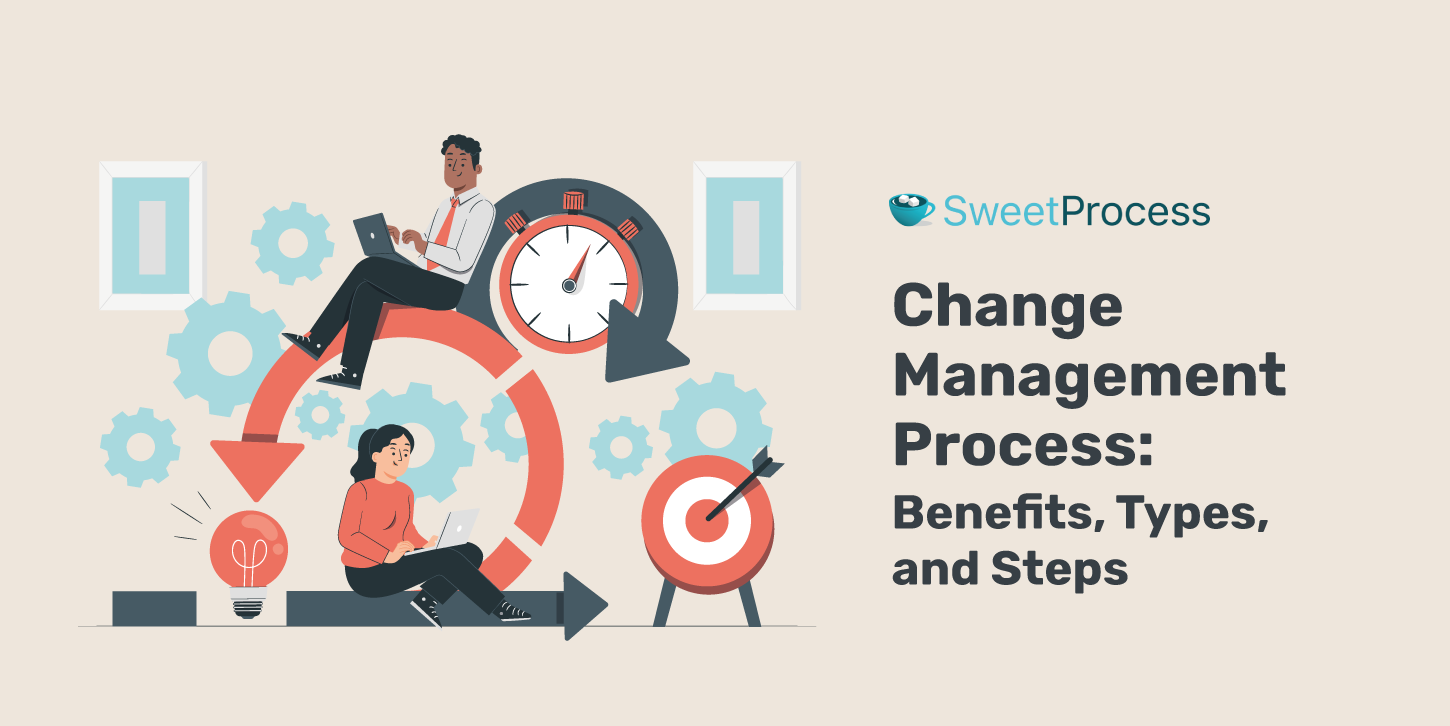
Change can be tough, but it’s very important for success in today’s business world. A study by Towers Watson research found that companies good at managing change are 3.5 times more likely to do better than others. Now, think about using this knowledge for your business development.
Change management isn’t just a process; it’s like a guide, helping companies become stronger and more innovative. Read on to pick insights that will help you better understand and handle business process change and lead your organization to success.
SweetProcess helps you to document your process changes. You can sign up for a 14-day free trial to see how it works without having to use a credit card.
Table of Contents
What Is a Change Management Process?
Benefits of Change Management Process for an Organization
Three Types of Change Management Process
The Change Management Process Steps and How to Set Them Up
How to Document and Communicate New Changes in Your Company Using SweetProcess
The Change Management Process Points of View
Common Barriers to a Seamless Change Management Process in an Organization
Seven Essentials of Effective Change Management Process
Document and Communicate New Changes in Your Company Seamlessly
What Is a Change Management Process?
The change management process is a structured way that organizations use to handle and navigate through process changes. It includes specific steps and strategies to smooth transitions and reduce resistance to the proposed change.
In simple terms, change management is like a guidebook for making changes in a company. It involves planning, communicating, and adapting to ensure that when something new happens, like a new system or process, everyone is on the same page and can adjust smoothly.
This process is key for businesses of all sizes and industries to ensure the successful implementation of changes with minimal disruptions.
Benefits of Change Management Process for an Organization
Structured Approach for Implementation
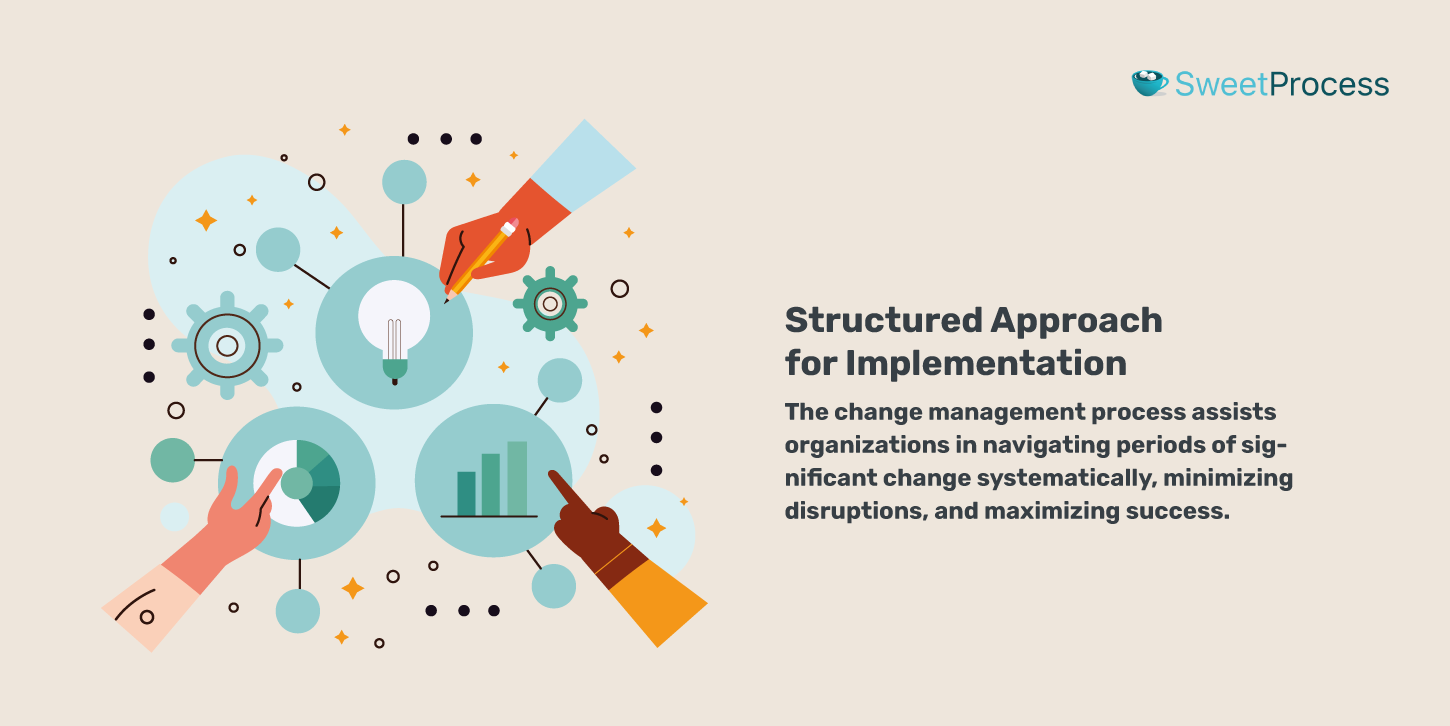
The change management process assists organizations in navigating periods of significant change systematically, minimizing disruptions, and maximizing success.
Identification and Addressing Resistance
A key benefit involves proactively managing employee concerns and fears and fostering higher acceptance and cooperation during times of organizational change.
Increased Employee Engagement and Alignment
Clear and effective communication fosters understanding of the reasons behind changes, contributing to organizational goals and empowering employees in their new roles.
Leadership Buy-In
Active involvement of leaders in the change process sets a positive example, inspiring employees to embrace changes, providing guidance, and ensuring a smooth transition.
Streamlines and Simplifies the Change Process
Change can often be hard and overwhelming for organizations. However, a well-implemented change management process can streamline and simplify the change process, making it more manageable and successful.
By providing a structured framework, a change management process ensures that all necessary steps and considerations are taken into account when implementing changes.
It helps organizations break down the change request into manageable tasks and creates a clear roadmap for each stage of the process.
Saves Time and Cost of Change
When companies implement process automation, they can manage changes more efficiently without disrupting daily operations. A well-structured change management plan ensures that resources are used effectively and tasks are completed on time.
By automating key processes, businesses not only save time but also reduce the risk of project delays and unexpected costs.
Ease Tracing of Faults
The organizational change management process gives a structure for keeping track of how changes are going. It helps find any problems or obstacles that might come up and assigns responsibility to people or teams for certain tasks. This way, organizations can quickly fix any mistakes or issues that arise during the process.
Three Types of Change Management Process
Understanding the different types of change management processes will help you pick the right one that works best for your organization, making the transition smoother.
Here are three types of change management process:
Developmental Change
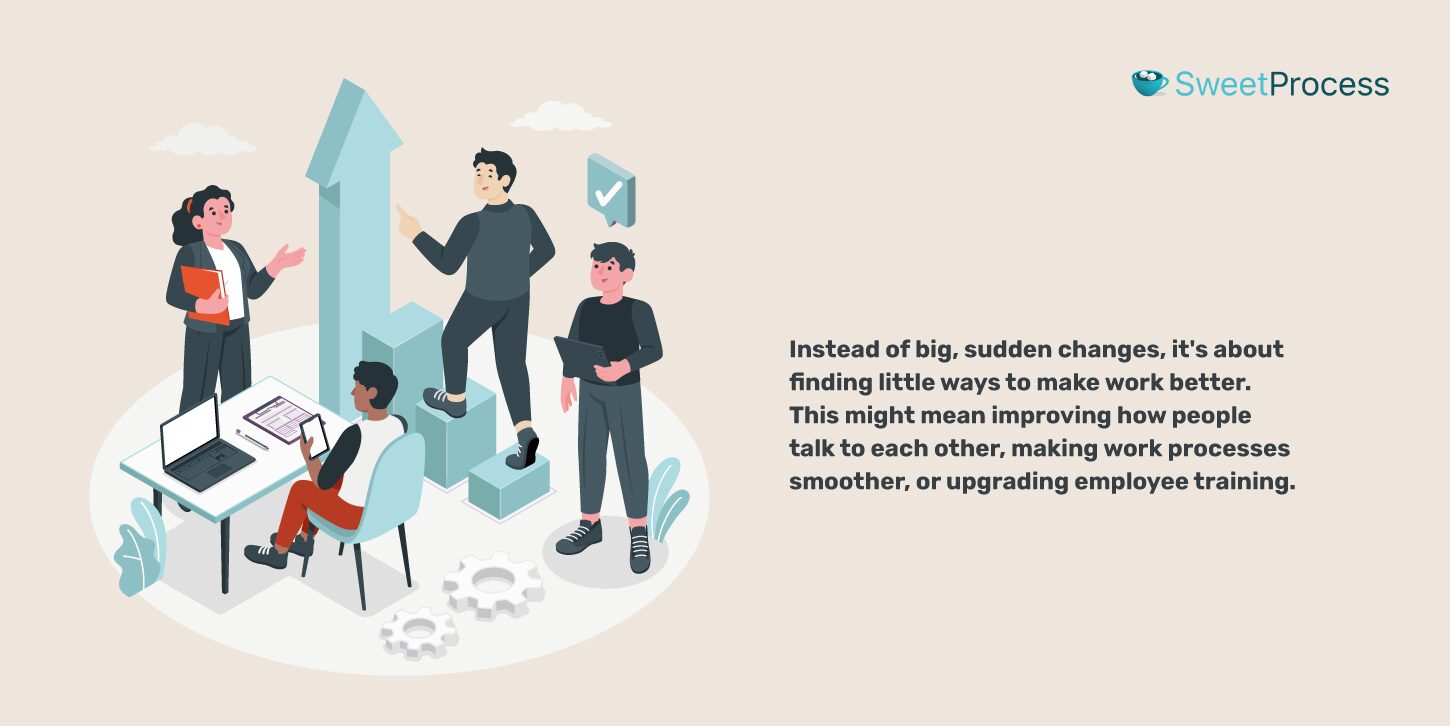
In simple terms, developmental change is like making small, steady improvements in how a company does things. Instead of big, sudden changes, it’s about finding little ways to make work better. This might mean improving how people talk to each other, making work processes smoother, or upgrading employee training.
The main idea is to always look for ways to do things better. It’s like a habit of constantly getting better at what the company does. By doing this, a company stays flexible and can adapt to new situations without causing too much chaos.
For example, imagine a company that realizes its communication can be clearer. Instead of changing everything at once, they might start with minor adjustments, like using a new messaging tool. Over time, these little changes add up, and the company becomes better at getting things done.
So, developmental change is about always getting better, step by step, without turning everything upside down. It’s a smart way for a company to grow and improve without causing too much upheaval.
Transitional Change
Transitional change is when a company goes through big, important shifts in how it works. This happens when there are major changes in how the company is organized, its strategies, or the way it does things. Unlike small improvements in developmental change, transitional change involves much bigger and more impactful transformations.
Things outside the company often cause these big changes, like when it merges with another company, gets new leaders, or when the market conditions shift a lot. When this happens, the company needs to plan carefully to make sure everyone can adjust smoothly to the new way of doing things.
A big part of transitional change is dealing with people’s worries about the changes. When things are changing a lot, employees might feel unsure or worried. Good change management means talking to them, providing training, and supporting them as the changes happen.
Even though transitional change can be tough, if it’s managed well it can make the company work better, be more competitive, and grow in the long run. It’s like making big changes to make the company stronger and more successful.
Transformational Change
Finally, transformational change is when a company goes through a huge makeover. This happens when the company needs to change its plans completely, the way it’s organized, and even how people think and work together. It’s not about slight developments—it’s about making a brand-new start.
This kind of change usually happens because the world around the company is changing a lot, like when people want different things or when new technologies come in. Instead of just adjusting a bit, it means the company needs to completely rethink everything—from its goals and values to how it does its work.
Making these big changes is difficult. It needs strong leaders, good communication, and a way to deal with people who might not like the changes. But if it’s done well, transformational change can bring enormous benefits, like making the company more creative, competitive, and able to grow for a long time.
Let’s look at simple steps you can take to carry out the change management process.
The Change Management Process Steps and How to Set Them Up
Change management is a complex process that requires careful planning and execution. To ensure a successful transition, there are seven key essentials that businesses must consider, plus we added examples for each step.
Clearly define the change
Before implementing any changes, it is important to define what needs to be changed and why clearly. This includes identifying the goals and objectives of the change as well as the potential benefits and challenges.
Example: Let’s assume a company implements a new customer relationship management (CRM) system to improve customer interactions and enhance data management. The goal is to increase efficiency and provide better services.
Create a change management team
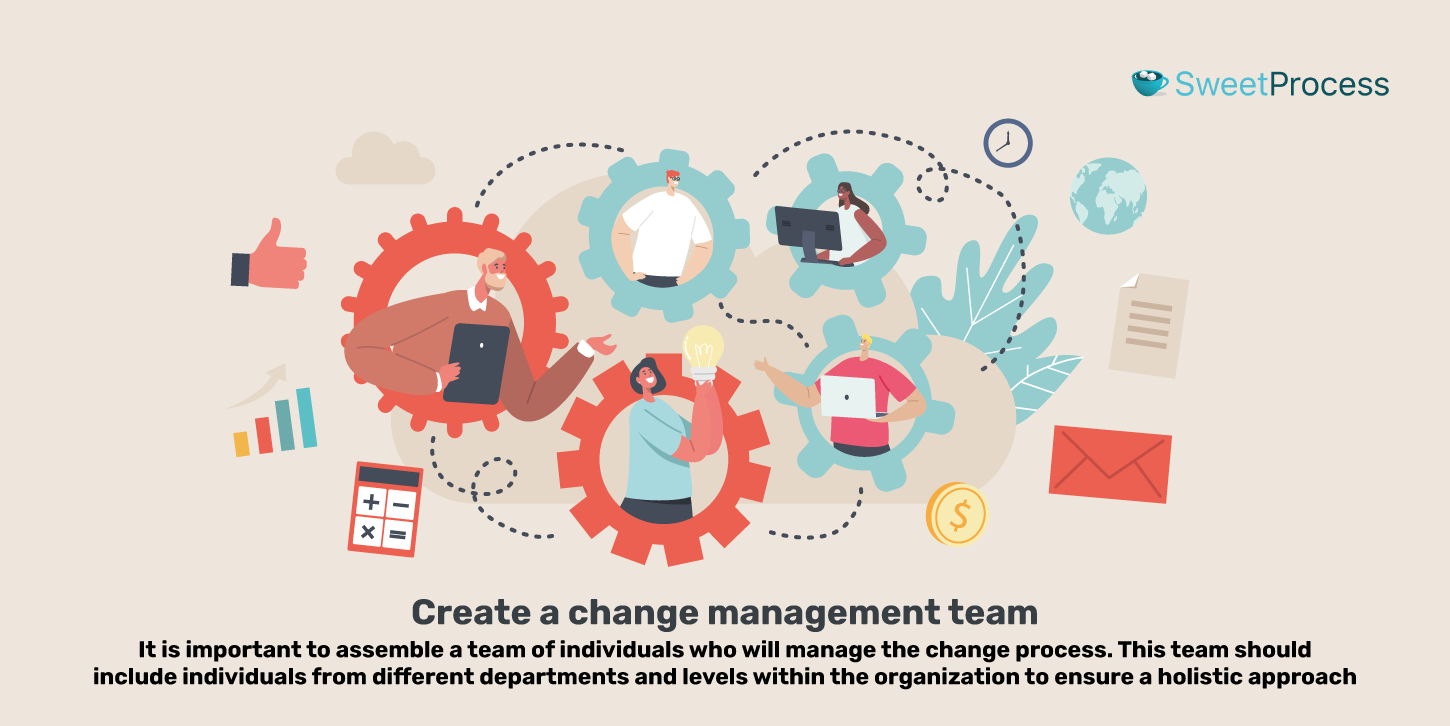
It is important to assemble a team of individuals who will manage the change process. This team should include individuals from different departments and levels within the organization to ensure a holistic approach.
Example: The change management team includes IT, customer service, and human resources representatives. Each member brings expertise from their department to ensure a well-rounded and effective approach to implementing the new CRM system.
Develop a communication plan
Effective communication is vital during times of change. It is important to develop a comprehensive communication plan that outlines the key messages, channels, and timelines for communicating with employees at different stages of the change process. This will help keep everyone informed and engaged.
Example: A communication plan outlines they will make initial announcements about the CRM change through company-wide emails. As the implementation progresses, they will provide regular updates through team meetings, intranet articles, and a dedicated online platform for employee questions and feedback.
Provide training and support
Change can be overwhelming for employees, so it is important to provide them with training and support. This can include training programs, workshops, and resources to help employees understand and adapt to the changes.
Example: Training sessions are organized to teach employees how to use the new CRM system. Online resources, such as video tutorials and user guides, are made available. Plus, a help desk should assist employees with any issues or questions they may have during the transition.
Manage resistance to change
Resistance to change is natural, but it is important to address it effectively. We can do this through open communication, addressing concerns and fears, and involving employees in the change process.
Example: Some employees might complain about the new CRM system affecting their daily tasks. The change management team holds town hall meetings to address these concerns, explaining the benefits of the system and how it will streamline processes, ultimately making their jobs easier.
Monitor and evaluate progress
Throughout the change process, it is important to regularly monitor and evaluate progress. This can help identify any challenges or issues and allow for adjustments to be made as needed.
Example: Regular check-ins are scheduled to assess how well employees are adapting to the new CRM system. Key performance indicators (KPIs) are tracked to measure the system’s impact on customer satisfaction, response times, and overall efficiency.
Celebrate successes
Celebrating successes, no matter how small can help boost morale and maintain momentum during the change process. Recognize and reward individuals and teams who have successfully adapted to the changes.
Example: Once the new CRM system is fully implemented, the organization celebrates by acknowledging departments and individuals who played a significant role in the successful transition. This recognition can be awards, a company-wide announcement, or a celebratory event.
By incorporating these steps into your change management strategy, you can increase the likelihood of a successful transition. Remember, change takes time and effort, but with the right approach, your organization can thrive in the face of change.
How to Document and Communicate New Changes in Your Company Using SweetProcess
How to Document Procedures, Processes, and Policies Using SweetProcess
Go to your “Procedures,” “Processes,” or “Policies” tab and click on “Create Procedure,” “Create Processes,” or “Create Policies” to start.

Ensure you add a title to it to make it easy to locate and memorable for your teammates.

You can then choose to add the procedure, process, or policy you’ve started to a particular team or different teams and click continue, as you can see in the image below.

Then write a description and add videos, images, or tags, and click on “Finished Editing” Save it.
How the Version History Feature Works in SweetProcess for Procedures, Processes, and Policies
If you’re not okay with a process change or just want to trace the person who made a change to a policy in the past, SweetProcess enables you to do that easily with the reliable time-tracking system called “Version History.”
Eric Burnside, vice president and director of business development at Independent Retirement, explained how this versioning feature helps them to easily track any process or procedural changes.
“You know what changes were made, so it makes it very easy to see the changes and the edits from one time to another. You can see the difference. You don’t have to read the entire procedure—you can see what was edited or added,’’ says Eric.
Now, if you’re wondering how it works, it’s simple. Just click on the version history when you have selected your procedure to view it, as you can see below.

How to Collaborate With Team Members on SweetProcess
You can collaborate with teammates on SweetProcess by either assigning roles or giving them a chance to leave a comment or share their opinions about a process change.
Enable Team Members to Give Feedback
SweetProcess allows you to collect feedback and share ideas about your processes.
To ask and gather feedback from your teammates on a process or company policy, pick the particular file you want to collaborate on and click on the first bullet point below “Feedback.”

Then tick one of the boxes to either; ask your teammates for feedback at the end of each article or display a contact form so they can type in their complaints and suggestions.
Entrust Your Employees With a Role to Handle
To give roles to your employees on SweetProcess, go to “Tasks” and then click “Assign Task.” Click on “Assign to teammates” to appoint someone to handle an assignment with a deadline for the project completion.
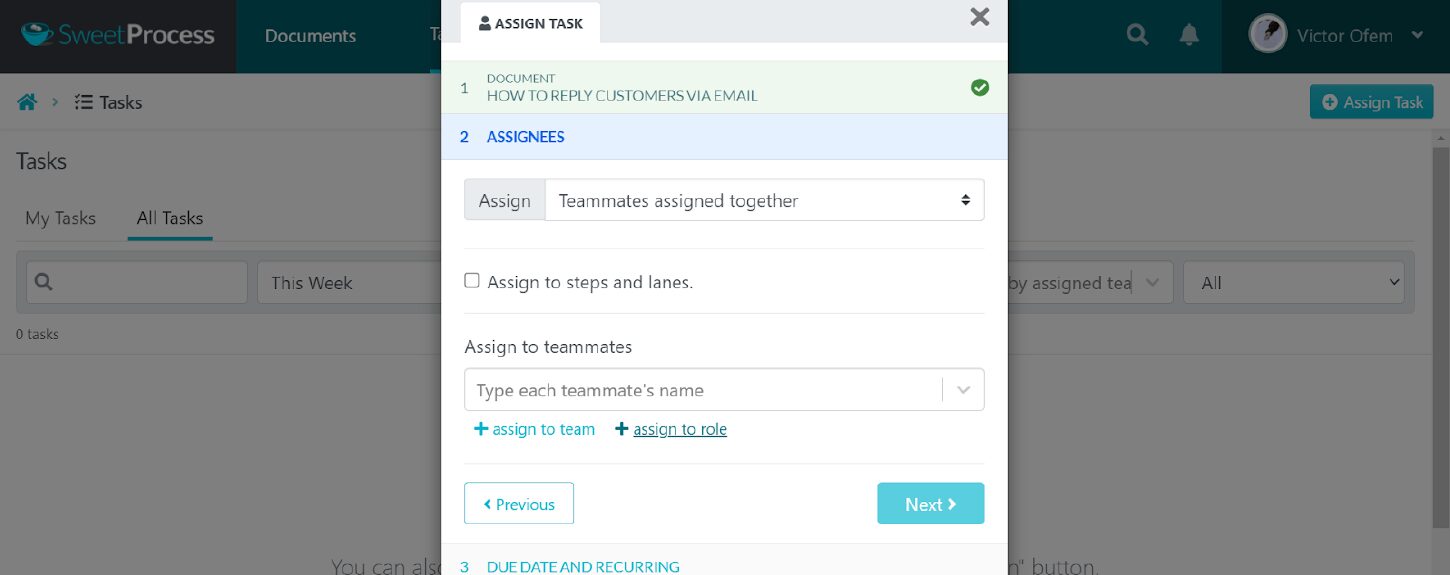
The fact is, that SweetProcess can simplify your workflow as a business owner or project manager.
Take Sarah Genay for instance, the portfolio analytics manager at Ginkgo Residential, who was asked to simplify workflows to boost employee productivity but they couldn’t do enough using PDF guides.
Luckily, she discovered SweetProcess and tried it, despite several tempting alternatives in the marketplace. Since they picked SweetProcess, Ginkgo Residential has been able to properly onboard new staff, eliminate recurring errors, and increase productivity without stress.
Here’s what she has to say after using our business process management tool:
“What we’ve been seeing is that it has helped us with onboarding for several employees…and I’ve been really happy to hear people who are working near me using it, and I’ve gotten good positive feedback on it.”
The Change Management Process Points of View
Understanding the change management process from different perspectives is key to implementing successful change within an organization.
By examining the viewpoints of employees, the organization, and leadership, we can gain valuable insights into the challenges and opportunities that arise during times of change.
With that said, let’s look at different points of view for the change management process.
Organizational Point of View
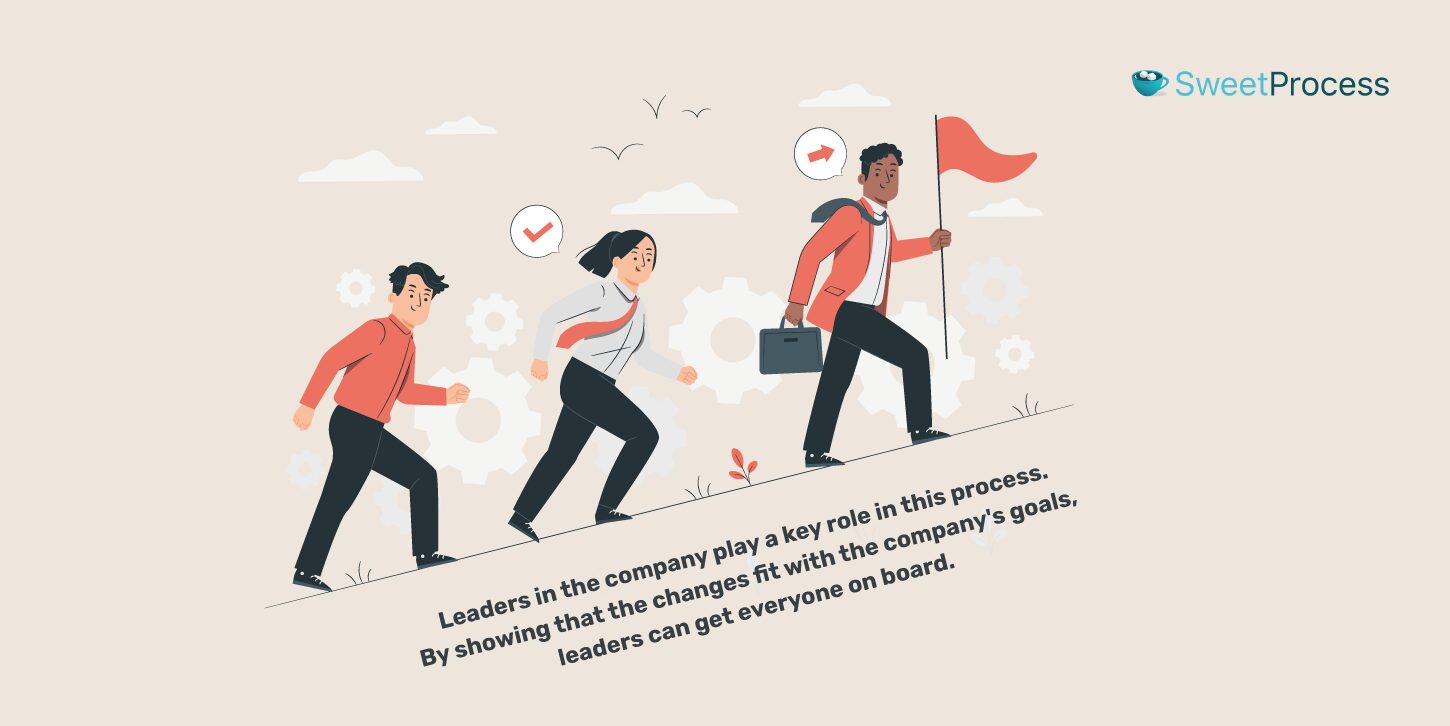
When a company goes through changes, it’s important to look at things from the company’s point of view. This means thinking about how the changes will impact the entire organization and whether they align with the company’s goals and usual way of doing things. This approach requires careful planning and making smart decisions to ensure the changes go smoothly.
Leaders in the company play a key role in this process. They need to explain to everyone why the changes are happening and make it clear why these changes are important. By showing that the changes fit with the company’s goals, leaders can get everyone on board. It’s also a decisive moment for leaders to ensure that the company has the resources to make the changes work.
During times of organizational change, anticipating and addressing potential issues is essential. Leaders need to be prepared for challenges, keep everyone informed, gather feedback, and create an environment where people feel comfortable expressing their thoughts. Building a company culture of trust and openness helps the organization adapt more effectively to changes.
Looking at changes from the company’s perspective also involves regularly checking how well the changes are working. Leaders need to assess whether the changes are helping the company reach its goals. If there are issues, leaders can make adjustments to get things back on track.
Employees’ Point of View
When things change at work, the employees have their thoughts and feelings about it. Change can make people feel unsure or uncomfortable because it shakes up their usual routines. The company needs to understand and deal with these feelings to make sure the changes go well.
Companies should talk openly with employees, be clear about what’s happening, and show empathy. It’s a good idea to include employees in the change right from the start. This makes them feel like they’re part of the plan, and it helps them feel more in control. The company can do this by giving regular updates, having meetings to answer questions, and asking for feedback.
It’s also important to provide training and support during changes. Giving employees the right tools and training helps them learn how to handle the new situation. This not only keeps employees interested in their work but also makes the change easier for everyone.
When some employees don’t like the change, it’s in the company’s interest to listen to their concerns. By paying attention, understanding worries, and offering reassurance, the company can build trust. This helps to ease employees’ worries and create an environment where everyone is okay with the changes.
In the end, considering how employees feel during changes is important. When the company understands their worries and needs, it can make the changes go smoothly. This way, employees feel supported and involved throughout the entire process.
Leadership Perspective
The way leaders see and handle changes is really important in making sure they work well in a company. Leaders are like guides who lead the way for the entire organization during changes. They set the mood for the transition and encouraged their teams to accept and welcome the changes.
For change to be successful, leaders need to have a clear idea of what the future should look like and share this vision with their teams. By explaining why the changes are happening and how they will benefit everyone, leaders create a sense of purpose and urgency among their employees. Leaders also need to be ready to adapt and change plans if unexpected issues come up.
Communication is key for a change leader. They need to be honest and understanding, knowing that change can be tough for employees. Leaders should give regular updates and chances for feedback, making sure their teams feel listened to and supported throughout the process.
Dealing with any resistance to change is also a big part of a leader’s job. They need to listen to concerns, offer reassurance, and support their teams. By staying strong and not giving up, leaders inspire confidence in their teams and help them accept the changes.
In the end, the way leaders see things is really important for change to go well. They need to guide their teams, inspire them, and deal with challenges that come with change. This way, leaders can lead the organization through a successful transition and reach the goals they have in mind.
Common Barriers to a Seamless Change Management Process in an Organization
Change management can be a complex process, and organizations often encounter common challenges when implementing changes. Here are some of the challenges.
Employee Resistance to Change
Employees often resist change because it disrupts their routines. To tackle this, organizations should communicate openly and involve employees in decision-making. This helps reduce resistance and increase acceptance.
Insufficient Resources
Many organizations face challenges because of limited time, effort, and resources for implementing change. To overcome this, prioritize resource allocation and consider seeking external support. This ensures the proper implementation of change initiatives.
Poor Communication
Poor communication can lead to misunderstandings and disengagement. To overcome this, prioritize effective communication strategies. This includes regular transparent communication using various channels and addressing employee feedback and concerns.
Manual Documentation of Changes
A big problem that often impedes a successful change management process in a company is the manual way changes are documented. A lot of organizations still use old-fashioned methods like spreadsheets or paper systems to write and keep track of changes. This way of doing things can be slow, take up too much time, and lead to a lot of mistakes.
Ineffective Change Management Plan
One of the key reasons for an ineffective change management plan is the absence of clear goals and objectives. Without a clear direction, employees may not understand why the change is necessary or what they need to achieve. This lack of clarity can lead to resistance, confusion, and, ultimately, the failure of the change initiative.
Inadequate Monitoring and Evaluation
Not keeping a close eye on and properly evaluating changes is another thing that often gets in the way of a smooth change management process in a company. After a process change is put into action, it’s really important to watch how it’s going and check if it’s working well.
If there isn’t careful monitoring and evaluation, organizations might find it hard to figure out and fix any problems or challenges that come up while the change is happening.
Seven Essentials of Effective Change Management Process
Leadership support
In order to successfully implement a change management process, it is crucial to have strong leadership support. The leadership team sets the tone for the rest of the organization and plays a vital role in driving the change forward. They need to clearly communicate the reasons for the change and its potential benefits to the entire company.
Clear vision and objective

A well-defined vision provides a roadmap for the organization and helps align everyone toward a common goal. It allows employees to understand the desired outcome and how their roles contribute to it. When crafting a clear vision and aim, it is important to be specific and measurable.
Communication strategy
A carefully planned communication strategy makes sure that everyone involved knows what’s happening and stays involved during a change. This means clearly and promptly explaining why the change is happening, what’s expected to result from it, and the steps that will be taken.
Communication methods should be diverse and customized to fit the preferences of different groups in the organization. Keeping everyone updated, having meetings, and creating open forums give employees chances to ask questions and express any concerns they have.
Employee involvement
When employees are actively involved in the change, they feel a sense of ownership and are more likely to embrace it. Involving employees in the decision-making process and seeking their input can lead to better outcomes and innovative solutions. You can do this through focus groups, surveys, or team discussions.
Training
By providing training, organizations can equip their workforce with the tools they need to embrace new systems, processes, or technologies. Training can take various forms, including workshops, seminars, online courses, or on-the-job training. It is important to tailor the training program to the specific needs of the employees and the changes being implemented.
Risk management
When implementing a change management process, it’s important to consider the potential risks and challenges that may arise. Risk management involves identifying potential risks, assessing their impact, and developing strategies to mitigate or address them. This approach helps organizations expect and minimize any negative effects of change.
Automation tools
Using automation tools can significantly improve how change management processes work. These tools make different tasks easier and more efficient during the transition. They help organizations by automating tasks that are done repeatedly, getting rid of mistakes made by hand, and boosting productivity.
Whether it’s project management tools or software that automates workflows, there are plenty of choices to help you handle change effectively.
Document and Communicate New Changes in Your Company Seamlessly
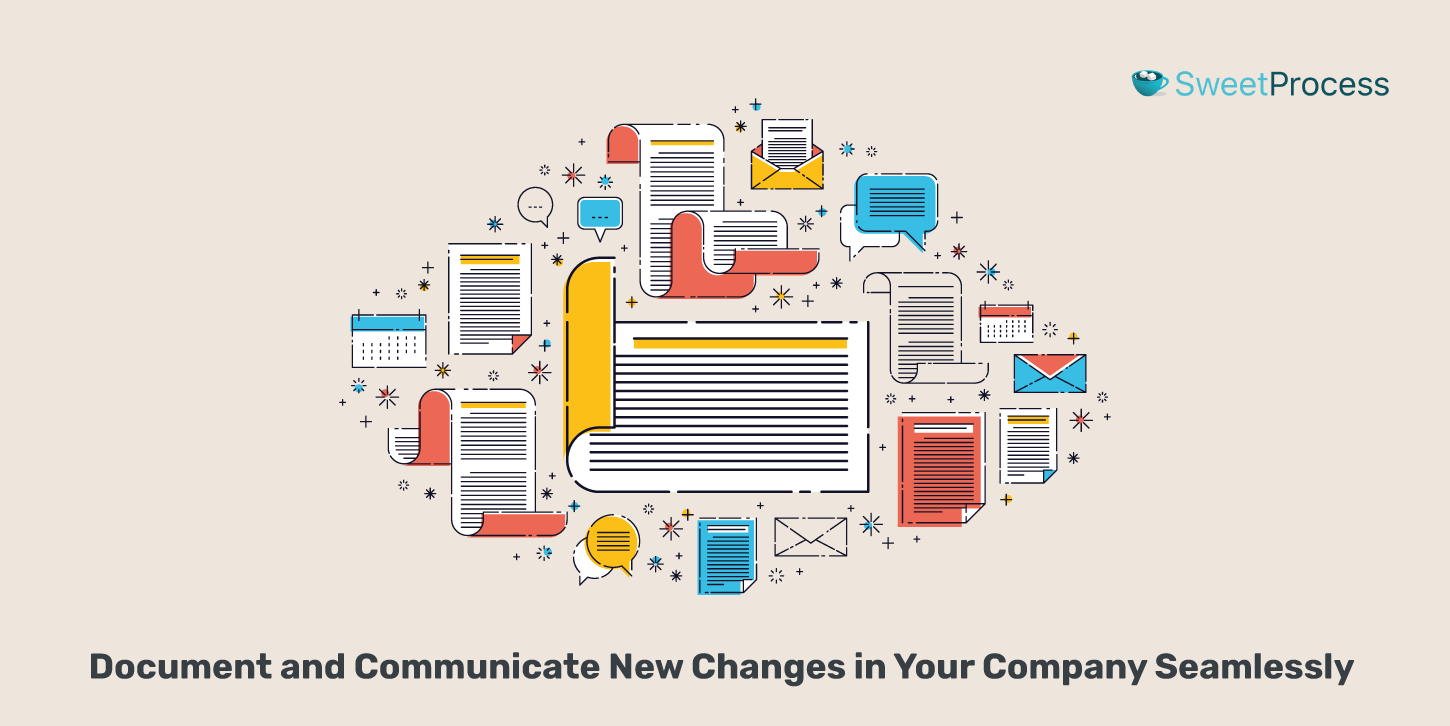
How your business navigates through process changes can increase or decrease your productivity, customer retention, and profits.
And it doesn’t have to be a stressful experience. It can be a smooth journey filled with learning and growth. With a reliable change management tool and a solid strategy, you can smoothly transition into different phases while meeting your business goals.
And yes, having handy an SOP software like SweetProcess can help you wade through the chaos with its intuitive interface and suite of functionalities, such as:
- Visual process maps
- Progress tracker
- Process version control and history
- Role-based access control
- Approval process access
- Business process automation
- Tasks management
- Collaboration tools
SweetProcess helps you seamlessly document, share, and manage processes to improve your efficiency, productivity, and profits. You can sign up for a 14-day free trial to see how it works without having to use a credit card.
